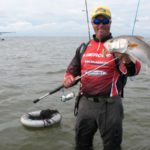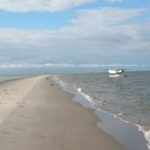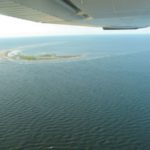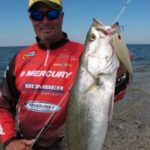
Sometimes you have to cover a lot of ground in November to find the fish, and this Lafitte-based guide says there’s no better way to do it than by seaplane.
Did you ever go to the circus when you were a kid? There really wasn’t anything else quite like it.
The circus was absolutely unique. And it was exciting. Music blared, and trapeze artists swung and hung high in the air by hands and feet. Wild animals like lions and tigers and elephants ran in circles in the big ring and jumped through hoops of fire.
Impossible numbers of clowns crawled out of teeny little cars, and we all held our breath as tight-rope walkers inched across the high wire, stopping to do handstands and balance themselves on bicycles and chairs.
It was wild and crazy and loud, and even though wafts of the pungent odor of animal poop permeated the whole place, we loved every minute of it. Nothing stands out in my childhood memory that was more thrilling than the circus.
Fast-forward 50 years and see the same spectacle from the eyes of a senior citizen. Funny, the things you never noticed before. Like how cheap and tawdry the whole thing is, and how shabby and worn the ringmaster’s coat looks. The animals look more tired than ferocious, the dare-devil stunts seem less daring and even the clowns seem to have lost their ability to make us laugh.
But there are still some things that are exciting, and thrilling, even for us jaded adults — and if you love to fish you’ll find few things more exciting than a float-plane trip aboard Capt. Theophile’s Flying Circus.
Theophile (pronounced “toe-feel”) Bourgeois (pronounced “Booge-wah”), grew up in the Lafitte waters and literally started holding a fishing rod in his hands while still in diapers. His family owned a fishing camp in the remote bayous, and the youngster spent as much time fishing as he possibly could.
That love of the waters and passion for fishing caused him problems trying to hold down a “regular” job, and eventually the lure of the outdoors became too hard to resist.
“I just up and quit,” Bourgeois said. “No notice or gradual tapering off: I just quit cold turkey and started charter fishing.”
That was almost 20 years ago and Bourgeois said he’s never regretted that decision.
But Bourgeois had another passion: flying.
And about 10 years ago when the call of the wild blue yonder was too strong to resist any longer, he bought an ultra-light aircraft. That temporarily satisfied his aviation appetite, but it also gave him the idea to do something unique, something no other charter captain was doing anywhere on the entire Gulf coast.
He bought a seaplane. And for the past four years he’s operated guided wade-fishing trips from that plane to Louisiana’s barrier islands.
Bourgeois has quite an operation headquartered in Lafitte. A huge, well-manicured mansion provides a guest lodge downstairs and living quarters for his family upstairs. The décor of the lodge is itself one of the circus attractions, serving as a cross between a museum, a camp and a curiosity shop.
He first based his charter business out of the family’s former camp, which was enlarged and expanded and still serves as a guest chalet. But home base houses the main lodge, the charter boat business and now the seaplane, and that’s where I climbed aboard his Cessna 185 seaplane, heading for some serious fishing at the barrier islands.
“We have a distinct advantage here in Louisiana,” Bourgeois said. “From Lafitte I can reach our barrier islands in the Gulf in 30 minutes, either to the west or the east.
“From right here we can be wade-fishing on Breton Island in half an hour, or I can head west and have you wading North Island in Timbalier Bay. You just can’t do that elsewhere along the Gulf coast.”
You have to travel light in the seaplane, so I left my heavy tackle bag in the truck. Besides, it was really unnecessary.
I did bring my wader belt, equipped with a single plastic box for some tackle, slots for my pliers and catfish flipper, a spare rod holder and clips to keep everything attached to the belt.
I brought two rods — one rigged with a topwater bait and another loaded with soft plastic in opening night/chartreuse.
And Bourgeois always carries a bunch of spares and his own wading backpack, so we were ready to fly. The Cessna seats four, but it’s a bit of a squeeze in the back seats. Fortunately it was just the two of us, so we had first-class seating and the plane to ourselves.
Once the engine roared to life ,we donned a set of earphones with a microphone, and the plane picked up speed along the Barataria Waterway runway and quickly lifted off.
Bourgeois keeps the plane low while flying over the marsh — and by low I mean under 1,000 feet. It all looks so different from the air, even when flying over what should be somewhat familiar territory.
We crossed the river and flew across parts of the Delacroix/Pointe a la Hache marsh, headed directly to our first stop: Breton Island.
Bourgeois calls this section of the Gulf islands the eastern triangle, and it includes Breton Island, Grand Gosier Island and Freemason Island that are included in the Chandeleur chain.
Curlew Island is no longer visible above the surface even at low tide, and though it is a very fishable underwater shoal the guide seldom includes it in his itinerary.
“This whole chain of islands holds tons of fish — both trout and redfish — and we also catch a variety of everything else: drum, Spanish mackerel, trash fish, you name it,” Bourgeois said. “But our target is always specks and reds, and November is pretty much the last time of the year when you can wade-fish and catch both.
“By December these islands will be surrounded by redfish, and the trout get much harder to find.”
We walked the entire length of Breton Island but couldn’t escape a hungry school of jacks that kept tearing up all our baits and stripping our lines.
I was standing just past knee deep and “walking the dog” with my topwater bait when a huge explosion erupted right in front of me; it caught me totally unprepared and almost bowled me over. But by the way it stripped out my line I knew what it was — a big, aggravating, bad-tasting, rod-bending, muscle-straining and line-breaking jack crevalle.
And when he broke my line (30-pound braid!), the fish kept my good topwater bait.
But we flew around, and landed and wade-fished along the beach of several of these islands. We caught redfish and we caught speckled trout, and the fishing just kept getting better and better as the day wore on.
“Think about the options that I have with the seaplane,” Bourgeois said. “I can fish either side, east or west. If I fly east and for some reason the fish just aren’t biting on that side, I can fly over to the west side where the fish are biting, or vice-versa.
“You just don’t have those options when you’re confined to a boat.”
“Yep! Versatility,” I answered.
And more fun than a car full of clowns.
Editor’s Note: Capt. Theophile Bourgeois can be reached at 504-341-5614 or www.neworleansfishing.com.
Destination Information
Lafitte is a 30- to 40-minute drive from downtown New Orleans. From the Westbank Expressway, turn south on Barataria Parkway to Louiana Highway 3134. Stay on Highway 3134 until it ends at state Highway 45, and turn left toward Lafitte. To get to Bourgeois’ lodge, turn right, cross the bridge at the blinking light in Lafitte and turn left on Privateer Road. You’ll see his sign just 100 yards down the road.
Marinas
Four main marinas offering fuel, ice, groceries, bait and accessories serve the Lafitte area:
• C&M Marina — 4932 Kenal Road;
504-689-2013; www.bayoufuel.com
• Seaway Marina — 5057 Kenal Road; 504-689-3148; www.c-waymarina.com
• Cochaira’s Marina — 4477 Jean Lafitte Blvd.; 504-689-3701
• Joe’s Landing — 4811 Privateer Blvd.; 504-689-4304 or 800-547-6501;
Charters/Guides
Many guides operate out of Lafitte, and many advertise in Louisiana Sportsman magazine (search this issue for their ads). The marinas also have guides working out of them and you can call them for recommendations.
However, Capt. Theophile Bourgeois is alone in operating a seaplane guide service. He can be reached at 405-341-5614 or at www.neworleansfishing.com.




